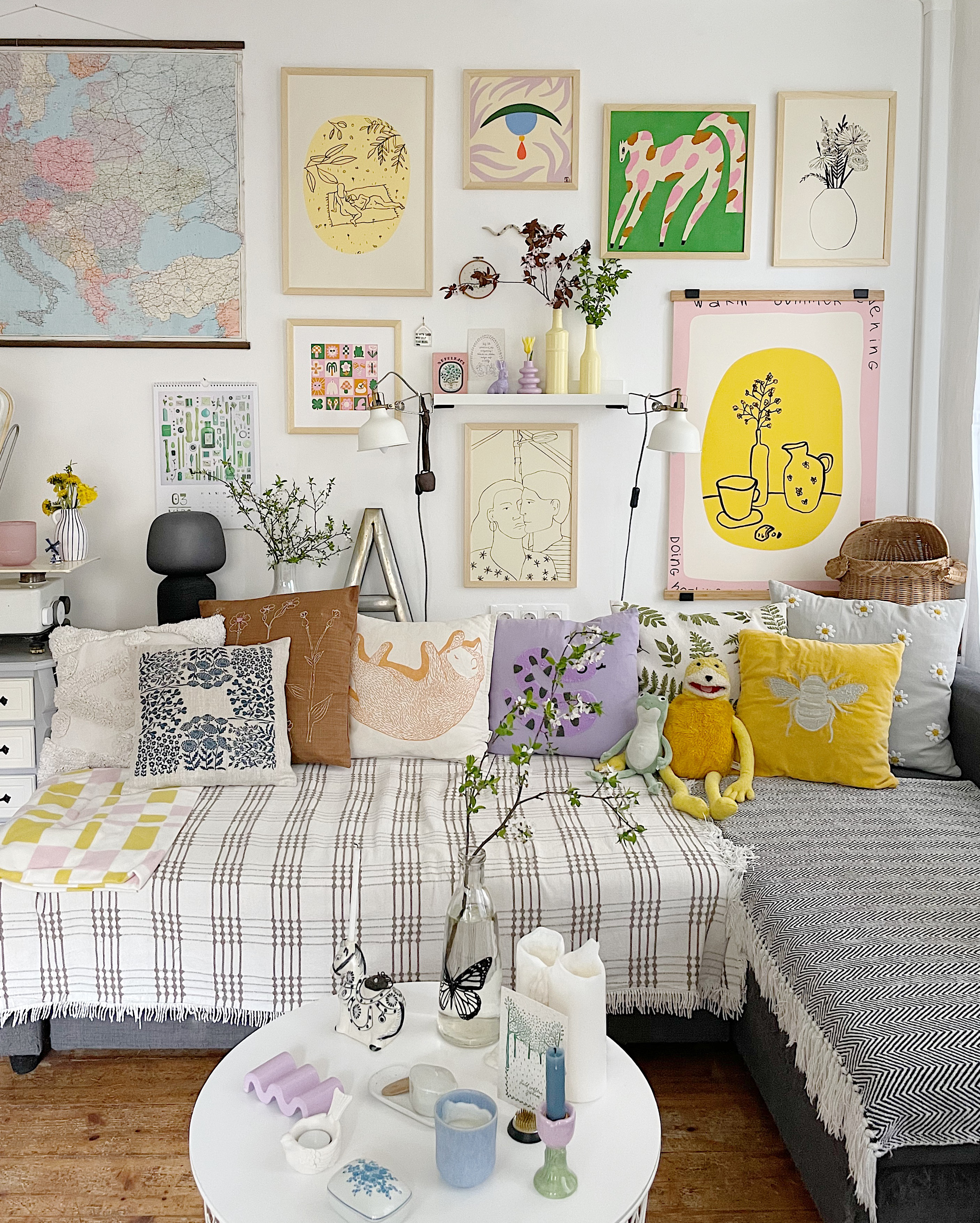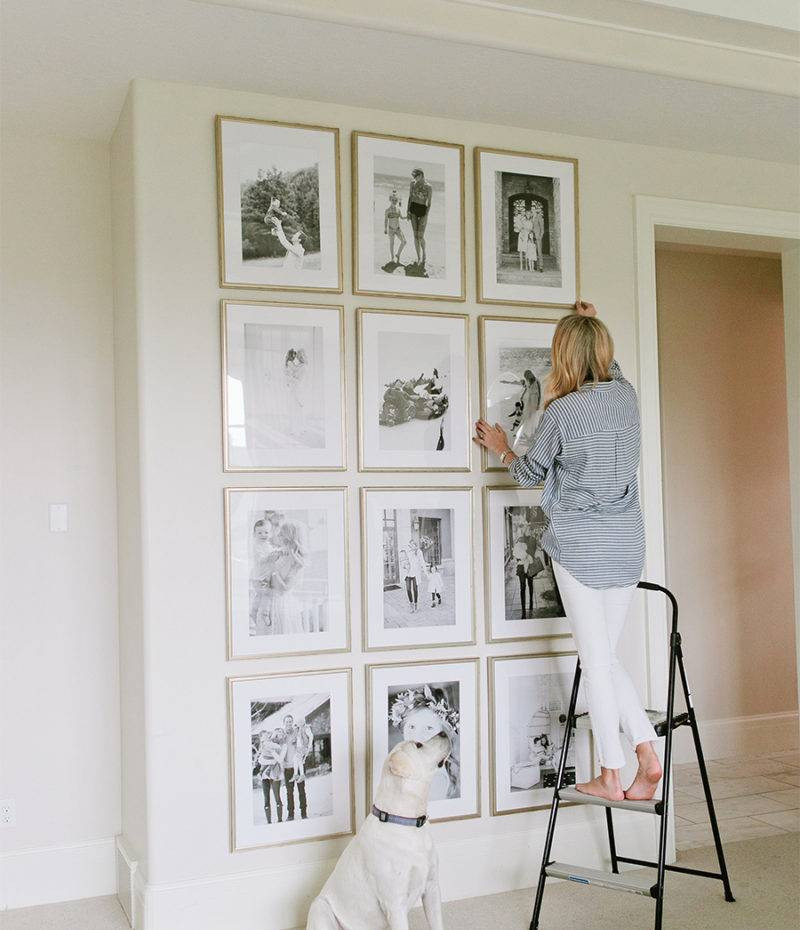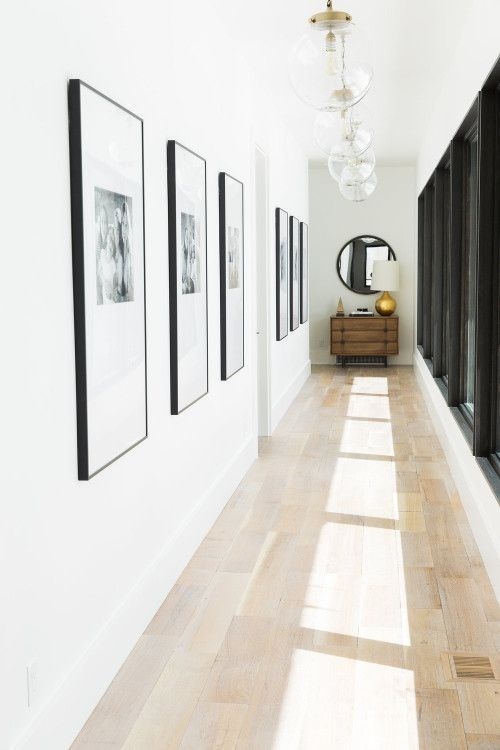Imagine walking into someone’s home and being greeted by an exciting, colorful gallery wall that tells a variety of stories. Guests stop in front of it; the pictures evoke thoughts and emotions. Each person sees something a little different: it conjures up different moods, brings back different memories, and everyone interprets it in their own way. But what’s truly special is that the gallery wall also tells a story about you. It reveals who you are, what inspires you, what matters to you – and this makes it easier for your guests to connect with you.
Now think about it: what greets your guests at home? An empty, white wall? Or a single, lonely picture? Maybe it’s time for your home to start telling its own story! If you don’t have a gallery wall, you’re definitely missing out! It’s not just about decoration: a gallery wall brings personality, style, warmth, and stories to your home. And best of all: it’s much easier to create than you might think!
Why is it good to have a gallery wall?
A gallery wall brings true uniqueness to your home – no one else will have exactly the same wall decor as you. While the big home decor stores often offer the same mass-produced prints and posters, a gallery wall you put together yourself is guaranteed to be personal and unrepeatable. Not only does this create a special atmosphere, but it also means you’ll avoid seeing the same picture at a friend’s or acquaintance’s house, which, let’s face it, can be a bit of a letdown.
Every piece on your gallery wall tells a story and is much more personal than any generic decoration. Behind the works of Artbridge artists are real people, feelings, and inspirations – these pictures don’t just decorate, they inspire you day after day, and can even become imprints of your own memories. So your wall not only looks beautiful, but it also tells your story: it shows what matters to you, who you are, and helps your guests connect with you more easily.
What’s more, you can refresh your gallery wall anytime: if you want a new mood, or spring is coming, you can simply switch the pictures for a fresh collection, or liven up the wall with a Christmas selection. There’s no need to drill new holes or make major changes – just take down the old picture and put up a new one, whether it’s a new Artbridge print or poster. This flexibility is much simpler than you might think, and allows your home to always reflect your current mood or the season.
What gallery wall layouts can you choose from?
One of the most exciting and important decisions when creating a gallery wall is choosing the layout. This will greatly influence the atmosphere of the space and how well it fits your home and personality.
- “Pure Chaos”
One of the freest and most creative solutions is “pure chaos,” or the random layout. In this style, you arrange pictures, posters, and illustrations of different sizes, colors, and styles seemingly at random, but still striving for a certain harmony. This kind of gallery wall is perfect for those who love playfulness and freedom, and aren’t afraid to let each picture on the wall convey a different mood or story. It looks especially good in bohemian, eclectic, or youthful homes, and is a great choice for living rooms or bedrooms where you can really unleash your creativity.

2. Precise, Grid Layout
If you prefer clean, organized spaces, the precise grid layout might be your style. In this arrangement, pictures of the same size are placed symmetrically, in perfectly measured rows and columns. This solution looks especially good in modern, minimalist, or Scandinavian interiors, where order, clarity, and harmony are key. Such a gallery wall is perfect for a study, office, or even a dining room-anywhere you want to emphasize simplicity and a calm atmosphere.

3. Staggered or Grid Layout
The third option is the staggered or grid layout, which works especially well in elongated spaces like hallways or staircases. In this style, the pictures follow an imaginary line, as if they were moving up or down a staircase, or they form a regular grid. This approach brings dynamism to the space, guides the viewer’s eye, and creates an especially exciting effect in transitional, high-traffic areas. If you want your guests to encounter your personality as soon as they enter your home or walk down the hallway, this is a truly striking choice.
Remember, you don’t have to commit to just one layout style! Feel free to combine them in different rooms of your home: for example, you can have a playful, free-form gallery wall in the living room, a neat, symmetrical arrangement in the study, and a staggered row in the hallway or staircase. The key is that each solution fits the space-and, even more importantly, your own personality. That’s how your gallery wall will truly feel like home and reflect who you are!

What’s the Ideal Size for a Gallery Wall? – Sizing Tips and Golden Rules
The size of your gallery wall is crucial for achieving a striking and harmonious result. As a general rule, it’s worth filling about two-thirds of the available wall space with your gallery wall-this way it will be prominent enough without overwhelming the room, and it won’t look lost either. If the gallery wall is too small, it can easily get lost on a larger wall and look random or unfinished, as if you just hung up a few pictures at random. On the other hand, if it’s too big, the whole space can feel crowded and overwhelming, especially in smaller rooms.
The placement of the bottom edge of the pictures is also important: if the gallery wall is above a piece of furniture (like a sofa, sideboard, or bed), the bottom edge of the pictures should be about 15–20 cm (6–8 inches) above the top of the furniture. This creates a visual connection between the furniture and the wall decor, so the pictures don’t “float” on the wall, but become an organic part of the space. If the pictures are hung too high, the whole composition falls apart and it’s harder for the eye to connect the furniture and the decor.
Keep your gallery wall airy: leave at least 3–5 cm (about 1–2 inches) of space between the pictures so each artwork can stand out and the wall doesn’t look overcrowded.

In smaller rooms, it’s better to choose fewer but larger pictures, as too many small images can make the space feel even more cramped. On larger walls, you can confidently use more, smaller pictures, but always pay attention to proportions and a tidy arrangement. Another rule is that the center of the gallery wall should be roughly at eye level (usually 145–155 cm from the floor), so the pictures become a natural focal point.
Your gallery wall will be truly harmonious if it’s proportional to the wall surface, has an airy arrangement, and the placement of the pictures is in harmony with the furniture and eye level. This way, the result will not only be striking but also comfortable and pleasing for everyone.
It’s important to see that a gallery wall is not just decoration, but the soul of your home-it tells your story and connects the space with your personality. A well-designed gallery wall is not only eye-catching and unique, but also inspires you every day, sparks conversations, and creates a real sense of home. Don’t let empty walls take away this opportunity-dare to play with styles, sizes, and layouts, and create a space that truly reflects you!
This post is the first part of a three-part series: in the next article, we’ll help you choose the right pictures, artworks, and themes for your gallery wall, and in the third part, we’ll show you step by step how to hang your selected pieces simply and professionally.
Stay with us and transform your home with a gallery wall-because every wall deserves to tell a story!



